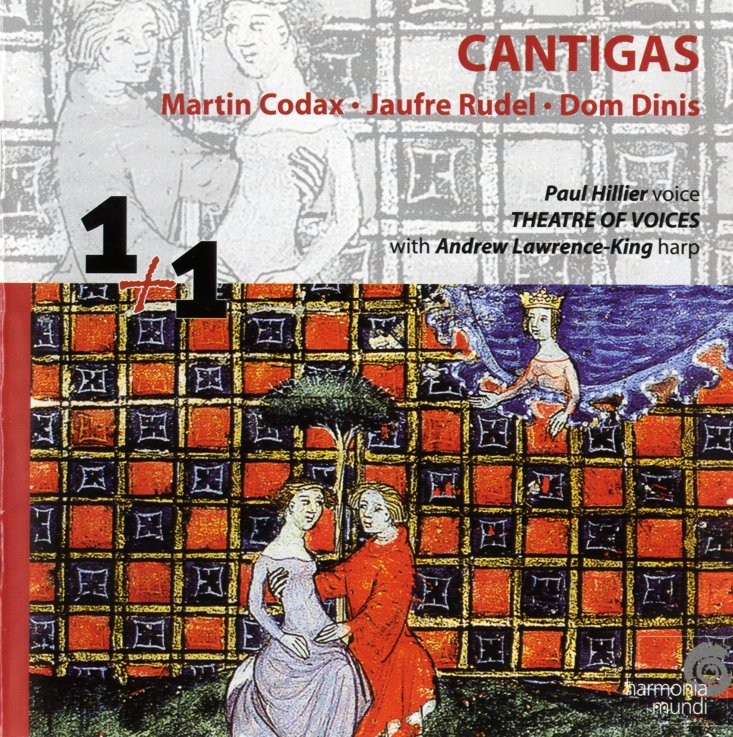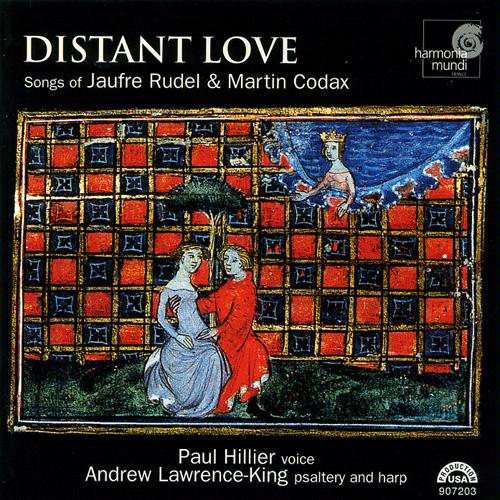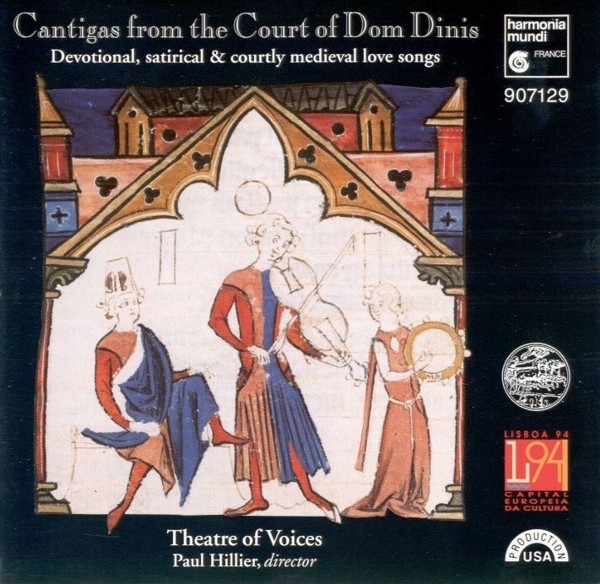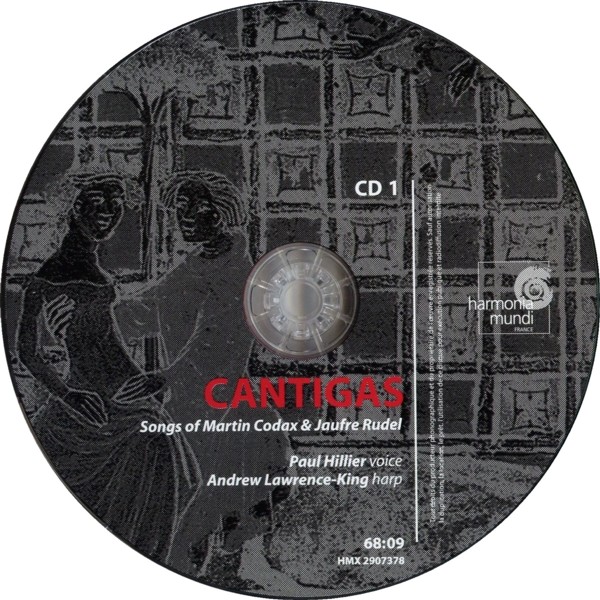
medieval.org
Harmonia Mundi HMX 290 7378-79
2006

medieval.org
Harmonia Mundi HMX 290 7378-79
2006
CD 1
DISTANT LOVE
Songs of Martin Codax and Jaufre Rudel
 Cantigas de Amigo by Martin CODAX
Cantigas de Amigo by Martin CODAX
fl. c. 1230
1. Prelude [3:29] psaltery
2. Ondas do mare de Vigo [2:47]
ca I
3. Mandad' ei comigo [2:05]
ca II
4. Mia irmana fremosa [2:10]
ca III
5. Ai Deus se sab'ora meu amigo [3:15]
ca IV
6. Quantas sabedes amare amigo [1:36]
ca V
7. En'no sagrado en Vigo [0:59]
ca VI
8. Ai ondas que eu vin veere [1:44]
ca VII
9. Postlude [3:57] harp
Six Songs by Jaufre RUDEL
fl. mid. 12th century
10. Quan lo rius de la fontana [8:17] with harp
11. Pro ai del chan essenhadors [5:25] with psaltery
12. Lanquan li jorn son lonc en mai [6:01]
LLJ
13. Belhs m'es l'estius e·l temps florit [5:04 with harp
14. No sap chantar qui so non di [7:13] with harp
15. Quan lo rossinhols el follos [9:13] with psaltery
16. Dansa. Instrumental Postlude [4:54] psaltery
Paul Hillier, voice
Andrew-Lawrence King, psaltery, harp
CD2
CANTIGAS from the Court of Dom Dinis
1. Porque ben Santa Maria sabe os seus dões dar [6:35]
CSM 327
2. Par Deus, ai dona Leonor [4:48]
Roi PAES de RIBELA · music: CSM 230
3. Un cavalo non comeu [2:46]
Joan GARCIA de GUILHADE · music: CSM 190
4. Non quer' eu donzela fea [3:46]
AFONSO X, o SÁBIO · music: CSM 231
5. Fois'o meu amigo a cas d'elrei [4:50]
Joan AIRAS de SANTIAGO · music: CSM 339
6. Quand'eu vejo las ondas [3:59]
Roi FERNADES de SANTIAGO · music: CSM 218
7. Muitas vezes volv'o demo [5:18]
CSM 198
 Sete cantigas d'amor de D. Dinis
Sete cantigas d'amor de D. Dinis
8. I. Pois que vos Deus, amigo, quer guisar [4:06]
9. II. A tal estado m'adusse, senhor [4:47]
10. III. O que vos nunca cuidei a dizer [6:00]
11. IV. Que mui gran prazer que eu ei, senhor [5:52]
12 V. Senhor fremosa, non poss'eu osmar [5:51]
13. VI. Non sei como me salv'a mha senhor [6:13]
14. VII. Quix ben, amigos, e quer'e querrei [4:51]
THEATRE OF VOICES
Paul Hillier, voice
Margriet Tindemans, vielle
Shira Kammen, vielle
Daniel Kennedy, percussion
chorus in the CSM: Hugh Davies, Tom Hart, Neal Rogers
Acknowledgments
Front cover: Illustration from a manuscript of the songs of Guillaume de Machaut,
Ms. fr. 22545, f. 162v / Bibliothèque nationale de France, Paris.
All texts and translations © harmonia mundi usa
© ℗ 1995, 2000, 2006 harmonia mundi usa
Recorded
February 16, 1994 (CD1 — Codax cantigas);
April 5, 1996 (CD1 — Cantigas prelude & postlude) &
February 14-16, 1994 (CD2) at Skywalker Sound,
a division of Lucas Digital, LTD, LLC, Nicassio, California.
October 1-2, 1998, at Le Domaine de Forget Charlevoix, Françoys-Bernier Concert Hall,
St. Irénée, Quebec, Canada (Rudel Songs CD1).
Executive Producer: Robina G. Young
Sessions Producers: Brad Michel (CD 1) / Robina Young & Dr. Manuel Pedro Ferreira (CD2)
Recording Engineers: Johanne Goyette (CD 1) & Brad Michel (CD2)
Editor: Paul F. Witt (CD 1) & Brad Michel (CD2)
Booklet Layout: Scarlett Freund & Isabela Klaus

Distant Love • Songs of Martin Codax & Jaufre Rudel
 Amor de loing:
invented by the 12th century troubadour Jaufre Rudel, this magic
formula still haunts our imagination. The poet-composers known as
troubadours flourished in Southern France beginning around 1100. They
wrote in the Romance tongue of their geographical area, the langue d'oc,
now called Old Provençal or Old Occitan. They elaborated poetic themes
and forms that would later characterize the European love song,
following a concept of lyric that brought words and music together in a
single work of art.
Amor de loing:
invented by the 12th century troubadour Jaufre Rudel, this magic
formula still haunts our imagination. The poet-composers known as
troubadours flourished in Southern France beginning around 1100. They
wrote in the Romance tongue of their geographical area, the langue d'oc,
now called Old Provençal or Old Occitan. They elaborated poetic themes
and forms that would later characterize the European love song,
following a concept of lyric that brought words and music together in a
single work of art.
Little is known about Jaufre Rudel. He was of
noble birth, lord of Blaye in southwestern France. It is generally
agreed that he took part in the crusade of 1147-48 and reached the Holy
Land, but there is no record that he returned to his native land. He is
the earliest troubadour from whom we have a significant number of
melodies: six poems and four melodies.
But the real Jaufre Rudel fades before the legend. The legend began with a 13th century biography, or vida,
relating the trip to the Holy Land. Short biographies accompany
troubadour songs in some manuscripts, offering a mixture of reliable
fact and wild fancy. Jaufre Rudel's vida places one of his songs,
"Lanquan li jorn son lonc en mai (When the days are long in May)", in
the context of crusade, claiming the poet undertook the journey not for
love of God but for love of a lady: the Countess of Tripoli. He fell in
love with her, so the story goes, without seeing her, and in the end,
died in her arms. The superb "portrait" of Jaufre Rudel and the Countess
illustrating the vida in one Italian manuscript captured the rapt adoration that is a crucial characteristic of distant love:
Jaufre Rudel's songs, all belonging to the genre of the canso, or love song, do not speak of any specific woman. The Old Occitan word for "lady," dompna,
so frequently encountered in the troubadour lyric is absent from his
poems. He sings instead of love unattained and unattainable, creating an
evocative amalgam of spiritual and physical desire. And for Jaufre
Rudel, as for other troubadours, the art of love is the art of
composition. "The song is good," he tells us, "carefully crafted and
rehearsed." His melodies are subtly varied within a general structure of
large-scale repetitions: A-A-B. Distant love is not only unrequited
longing but also supreme artistry.
•
Of
the life of Martin Codax, who flourished nearly a century later than
Jaufre Rudel, almost nothing is known. He likely lived in the coastal
town of Vigo, situated above Portugal in Galicia. We owe knowledge of
his music to the chance discovery in 1913 of a manuscript — a single
leaf tucked away in the binding of a book — by a Madrid bookseller,
Pedro Vindel, which is now in the Pierpont Morgan Library in New York.
This discovery has allowed us to savor the earliest group of vernacular
songs from the Iberian peninsula.
Martin Codax cultivated the cantiga de amigo,
the "song of a (boy)friend." Although this poetic genre can be loosely
situated in the Galician-Portuguese troubadour tradition, the cantiga de amigo
is thought to be indigenous to the Iberian peninsula and related to the
archaic European tradition of women's songs. The point of view in
Codax's cantigas is that of a girl from Vigo looking out over the sea,
longing for a lover who does not come. But the songs were composed and
probably sung by a man.
The language of the cantigas de amigo
was Galician-Portuguese (or Gallego-Portuguese), a Romance tongue and,
like Old Occitan, a prestigious vehicle for poetry. Later in the 13th
century, it would be adopted by Alfonso the Learned for his magnificent
collection of Las Cantigas de Santa Maria. All Codax's cantigas have the same form (suggesting they might have been a song cycle) and this form is different from that of the troubadour canso.
Its characteristic features are parallelism and the use of a refrain.
Ideas unfold in two parallel lines, the couplet, which are then followed
by the refrain. In succeeding stanzas, initial portions of lines are
repeated with the end (rhyming word) changed, followed again by the
refrain. Melodic means are simple and also make generous use of
repetition. This creates an intricate series of recurrences to express
an obsessive preoccupation with the absent friend. As the repetition of amor de loing
in Jaufre Rudel's song, so the reechoing lines of Martin Codax's
cantigas mirror in its very essence the unending desire for distant
love.
MARGARET SWITTEN
Cantigas from the Court of Dom Dinis
DOM
DINIS (1261-1325), King of Portugal from 1279, was as renowned for his
love of Galician-Portuguese troubadour song as for his progressive
policies. A troubadour himself, Dom Dinis encouraged song-making and
rewarded new talent; his own songs (cantigas), of which 137
texts survive, earned him more than justified acclamation from his peers
and from future generations of poets. It was during his reign that the
impressive Cancioneiro da Ajuda was compiled; later documents
tell us about other volumes from the King's household, now unfortunately
lost — a songbook containing Dinis's secular songs, and another
containing cantigas in honor of Mary. A grandson of Alfonso X the
Learned, King of Castile and Leon, the outstanding poet and compiler of
the Cantigas de Santa Maria, he was his grandfather's true heir
where poetry, music and culture are concerned; at his court all the
genres and tendencies of troubadour song were to be found.
The Galician-Portuguese Troubadour Tradition
Galician-Portuguese
is the romance language spoken in Westernmost Europe, the Atlantic
coastal strip of the Iberian Peninsula: Galicia, in the north (now part
of Spain), and Portugal, an independent nation since the early 12th
century. For historical and linguistic reasons, Galician-Portuguese was
also the standard poetic language in the Leonese and Castilian kingdoms
(North-Central Spain) up to the 14th century.
The troubadour
tradition in the Western and Central Hispanic areas has a double origin:
that of Southern French troubadours in aristocratic circles in the area
immediately to the East of the Road to Santiago, and the strong
Galician tradition rooted in local song-making, a consequence of the
religious importance of Santiago de Compostela. From these two sources
an original approach to courtly song came into being; between the late
12th and the mid-14th centuries, authors of different social backgrounds
composed hundreds of secular cantigas of different genres, of which
about 1680 texts have survived. To these poems may be added more than
400 songs dedicated to the Virgin Mary, the well-known Cantigas de Santa Maria compiled at the court of Alfonso X.
Unfortunately,
most of the music for secular cantigas perished in the centuries that
followed the demise of the tradition, around the year 1350. Only two
documents are known to survive: the Vindel MS, a single, folded leaf
found in 1913 by the Madrid bookseller Pedro Vindel; and the Sharrer MS,
a fragment from a Portuguese Cancioneiro found in 1990 by the
California-based Professor Harvey Sharrer. Both manuscripts were
probably written in the late 13th century. The Vindel MS, now at the
Pierpont Morgan Library in New York, contains music for six of the seven
songs by Martin Codax, a Galician minstrel active in the mid-13th
century. The Sharrer MS, kept at the Torre do Tombo in Lisbon, has
musical notation for seven compositions by the Portuguese King Dom
Dinis.
The situation is completely different with the Cantigas de Santa Maria:
almost all of them survive with music, found in three medieval codices.
Like the Vindel and Sharrer MSS, the C.S.M. codices have an
extraordinary interest for the quality and originality of their musical
content; the semi-mensural character of the musical notation in these
sources allows for a relatively safe rhythmic transcription and hence
for added authenticity in melodic performance.
Cantigas de Amigo
The
songs by Joan Airas and Roi Fernandes de Santiago, as well as those by
Martin Codax, belong to the genre "cantiga de amigo". This kind of
cantiga was composed and generally sung by a man; it was nevertheless
supposed to convey the feelings and thoughts of a young woman longing
for her absent boyfriend. The poet tended to use an archaic technique
known as "parallelism", which called for the presentation of the same
idea twice in alternating lines, with slightly different wordings. The
stanzas were short and were generally followed by a refrain; the refrain
was not meant to be choral, and may have been freely rendered by the
singer.
The music for the cantiga Fois'o meu amigo a cas d'elrei (ed. Rodriguez) by Joan Airas de Santiago is based on C.S.M. No. 339; the melody for Quand'eu vejo las ondas
(ed. Tavani) by Roi Fernandes de Santiago is taken from C.S.M. 218.
Both poets came from Santiago de Compostela and were contemporaries of
Alfonso the Learned.
Cantigas de Amor
The cantiga de amor is the Galician-Portuguese version of the Provençal canso
— the most aristocratic of song genres — but is generally shorter and
often includes a refrain; the content tends to be more abstract and
conventional than its French counterparts. Dom Dinis was famous for his
impeccable technique and rich literary imagination; he is known to have
composed 73 cantigas de amor, of which only seven have survived
with music. The manuscript which records these melodies is
unfortunately seriously damaged, and as a consequence the first modern
performance of the complete songs after their discovery in 1990 had to
await painstaking transcription and reconstruction work, completed in
1993 by Sharrer and Ferreira; in the cantigas 6 and 7 two entirely new
musical phrases, marked by their use of the B-flat, had to be inserted.
The music is unusually melismatic, and has a large number of ornamental
notes. Modal rhythm was sparingly used, being found in syllabic
passages, the most important principle being that of approximate equal
duration for each syllable carrying more than one note.
The cantiga de amor Par Deus, ai dona Leonor
(ed. Michaëlis de Vasconcellos) by Roi Paes de Ribela, a troubadour
active in the second half of the 13th century, was set to music from
C.S.M. 230, which has the same florid isosyllabism found in Dom Dinis;
the beginning recalls the style of Martin Codax.
Cantigas de Escarnio e Mal-dizer
The third most important genre in Galician-Portuguese lyricism was that of satirical song: cantigas de escárnio (oblique criticism) or mal-dizer
(open criticism, with frequent use of obscene words). Alfonso X seems
to have particularly enjoyed satire, and tried his own hand at it, as
illustrated here by Non quer'eu donzela fea (ed. Lapa), a cantiga de mal-dizer directed against an ugly woman who enjoys farting. The melody is taken from C.S.M. 231. Another satirical song, Un cavalo non comeu by his contemporary Joan Garcia de Guilhade, fits the music for C.S.M. 190 exactly; the text, an escárnio with hidden erotic meaning, is based on Lapa's edition, slightly modified.
Cantigas de Santa Maria
The Cantigas de Santa Maria
compiled in the court of Alfonso the Learned are, unlike the secular
cantigas, mostly narrative, and tend, also uncharacteristically, to
adopt the formal features of the Andalusian zajal, a moorish song
inspired by old Hispanic traditions. They generally call for a choral
repeat of the refrain after each stanza, but some of them seem to have
dispensed with it. Although composed in the Castilian court between 1264
and 1284, their language is Galician-Portuguese; Galician and
Portuguese troubadours were at the service of Alfonso. 25 cantigas
narrate events which had occurred in Portugal (three additional cantigas
also refer to Portuguese people). The Marian Sanctuary of Terena
(Alandroal, Évora) accounts for twelve cantigas; Terena, Elvas (two
songs), Évora, Odemira and Estremoz are all located in Alentejo (south
of the river Tagus, north of the Algarve). It might be significant that
King Dinis's brother, prince Alfonso, who was a landlord in the
Alentejo, lived in the Castilian court in 1281, at the time of the final
additions to the Marian collection. Other cities referred to in the
C.S.M. are Lisbon and the strategically important city of Santarem, both
by the Tagus, and Faro in the Algarve, the southern-most part of the
country, a Christian city known for its devotion to Mary even during the
five centuries of Arab rule. Only two cantigas refer to events north of
the Lisbon area.
The valuable musical edition of the C.S.M. made
by the Catalan musicologist Higinio Angles is usually retained by
performers; yet, since his transcriptions of cantigas 198 and 327 mirror
some misunderstanding of the original notation, they have been
corrected accordingly. The texts have been taken from Walter Mettmann's
edition.
The musical adaptations of the C.S.M. to secular texts follow the rules of musical contrafactum
as explained in a fragmentary medieval treatise appended to one of the Galician-Portuguese Cancioneiros;
the transcriptions are based on the MSS and published by Ferreira in an Appendix to his book on Martin Codax (Lisbon, 1986).
MANUEL PEDRO FERREIRA
